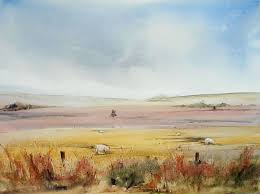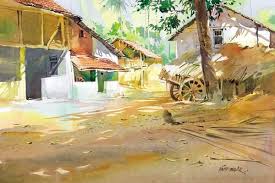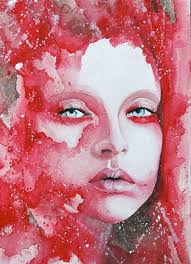Source:- Google.com.pk
Watercolor Paintings Biography
David Cox (29 April 1783 – 7 June 1859) was an English landscape painter, one of the most important members of the Birmingham School of landscape artists[1] and an early precursor of impressionism.[2]
Contents [hide]
1 Early life
2 Career
3 Public collections
4 Gallery
5 David Cox Junior (1809-1885)
6 References
[edit]Early life
Cox's birthplace, illustrated by his teacher Samuel Lines
Cox was born on 29 April 1783 in Deritend, Birmingham, the son of a blacksmith, who went on to become one of the most important figures in British Art during the so-called Golden Age of watercolour painting. He was considered by his contemporaries to be rivalled only by Constable in his portrayal of nature's moods and the British weather. In 1852 The Spectator claimed, "in his works there are power and insight enough to swamp all the others put together."
He studied drawing under Joseph Barber before being apprenticed to a maker of fancy articles named Fieldler in around 1798, where he soon learnt to paint portrait miniatures. Following Fieldlers suicide, he was next employed as an assistant to scene-painter De Maria in the Birmingham theatre. In 1804, he took up work as a scene painter at Astleys Theatre and moved to London living in Vassall Road, Brixton. While living in London, Cox married his landlord's daughter, Mary Agg and the couple moved to Dulwich in 1808. In the same year, he abandoned scene-painting for the theatre, and took up watercolour painting for which he became famous.
[edit]Career
David Cox Travellers on a Path, pencil and brown wash.
In 1805 he made his first of many trips to Wales, with Charles Barber, his earliest dated watercolours are from this year. Throughout his lifetime he made numerous sketching tours to the Home Counties, North Wales, Yorkshire, Derbyshire and Devon.
Cox exhibited regularly at the Royal Academy from 1805. His paintings never reached high prices, so he earned his living mainly as a drawing master. His first pupil, Colonel the Hon.H. Windsor (the future Earl of Plymouth) engaged him in 1808, Cox went on to acquire several other aristocratic and titled pupils. He also went on to write several books, including: Ackermanns' New Drawing Book (1809); A Series Of Progressive Lessons (1811); Treatise on Landscape Painting (1813); and Progressive Lessons on Landscape (1816). The ninth and last edition of his series Progressive Lessons, was published in 1845.
By 1810 he was elected President of the Associated Artists in Water Colour. In 1812, following the demise of the Associated Artists, he was elected as associate of the Society of Painters in Water Colour (the old Water Colour Society). He was elected a Member of the Society in 1813, and exhibited there every year (except 1815 and 1817) until his death. In about 1814-1815 he went on to be appointed as Drawing Master at the Military Staff College, Farnham. With his appointment as Drawing Master at a Miss Crouchers' Girls School, he took up residence in Hereford. Between 1823 and 1826 he had Joseph Murray Ince as a pupil.[3] He made his first trip to the Continent, to Belgium and the Netherlands in 1826 and subsequently moved to London the following year.
He exhibited for the first time with the Birmingham Society of Artists in 1829, and with the Liverpool Academy in 1831. In 1839, two of Cox's watercolours were bought from the Old Water Colour Society exhibition by the Marquis of Conynha for Queen Victoria.
Beach of Rhyl, before 1854.
Cox lived in Hereford and London between 1804 and 1840, returning to Birmingham to live in the suburb of Harborne. Around 1840, Cox took up oil painting, studying under W. J. Miller. In order to do this, he handed over much of his teaching work to his only son, David Cox Jnr (1809–1885). He went on to exhibit two oil paintings at the Royal Academy in 1844. From 1844 until 1856 he spent summers at Betws-y-Coed in North Wales. His health suffered following a stroke in 1853. In 1855 he was represented by watercolours at the Paris Universal Exhibition.
By 1857 however, his eyesight had deteriorated. An exhibition of his work was arranged in 1858 by the Conversazione Society Hampstead, and in 1859 a retrospective exhibition was held at the German Gallery Bond Street, London. Cox died several months later. He was buried in the churchyard of St Peters, Harborne, Birmingham, under a chestnut tree, alongside his wife Mary.
[edit]Public collections
Several of his works are in Birmingham Museum & Art Gallery, having been donated by Joseph Henry Nettlefold, on the condition it opened on Sundays.[4] His work can also be seen at the British Museum, the Tate Gallery, and in Manchester, Newcastle, Liverpool, Edinburgh, Oxford and Cambridge. The Lady Lever Art Gallery, Port Sunlight shows a number of Cox's watercolours bought by Lever through James Orrock. Some of them have since been confirmed as forgeries. An exhibition of his work was held at the Yale Center for British Art in the USA in 2008, travelling to Birmingham in 2009.[1]
There are two Blue Plaque memorials commemorating him at 116 Greenfield Road, Harborne, Birmingham, [2], and at 34 Foxley Road, London, SW9. [3]. It can also be seen at the David Cox exhibition in Birmingham.
His pupils included Birmingham architectural artist, Allen Edward Everitt (1824–1882).
[edit]Gallery
Boys Fishing by David Cox
[edit]David Cox Junior (1809-1885)
David Cox had a son of the same name who followed his calling as a watercolour painter. He was born in Dulwich, but educated in Hereford. He exhibited in London from 1827, although today he is known mainly through association with his father. He died in Streatham on 4 December 1885 and was buried at West Norwood Cemetery.








Watercolor Paintings Biography
David Cox (29 April 1783 – 7 June 1859) was an English landscape painter, one of the most important members of the Birmingham School of landscape artists[1] and an early precursor of impressionism.[2]
Contents [hide]
1 Early life
2 Career
3 Public collections
4 Gallery
5 David Cox Junior (1809-1885)
6 References
[edit]Early life
Cox's birthplace, illustrated by his teacher Samuel Lines
Cox was born on 29 April 1783 in Deritend, Birmingham, the son of a blacksmith, who went on to become one of the most important figures in British Art during the so-called Golden Age of watercolour painting. He was considered by his contemporaries to be rivalled only by Constable in his portrayal of nature's moods and the British weather. In 1852 The Spectator claimed, "in his works there are power and insight enough to swamp all the others put together."
He studied drawing under Joseph Barber before being apprenticed to a maker of fancy articles named Fieldler in around 1798, where he soon learnt to paint portrait miniatures. Following Fieldlers suicide, he was next employed as an assistant to scene-painter De Maria in the Birmingham theatre. In 1804, he took up work as a scene painter at Astleys Theatre and moved to London living in Vassall Road, Brixton. While living in London, Cox married his landlord's daughter, Mary Agg and the couple moved to Dulwich in 1808. In the same year, he abandoned scene-painting for the theatre, and took up watercolour painting for which he became famous.
[edit]Career
David Cox Travellers on a Path, pencil and brown wash.
In 1805 he made his first of many trips to Wales, with Charles Barber, his earliest dated watercolours are from this year. Throughout his lifetime he made numerous sketching tours to the Home Counties, North Wales, Yorkshire, Derbyshire and Devon.
Cox exhibited regularly at the Royal Academy from 1805. His paintings never reached high prices, so he earned his living mainly as a drawing master. His first pupil, Colonel the Hon.H. Windsor (the future Earl of Plymouth) engaged him in 1808, Cox went on to acquire several other aristocratic and titled pupils. He also went on to write several books, including: Ackermanns' New Drawing Book (1809); A Series Of Progressive Lessons (1811); Treatise on Landscape Painting (1813); and Progressive Lessons on Landscape (1816). The ninth and last edition of his series Progressive Lessons, was published in 1845.
By 1810 he was elected President of the Associated Artists in Water Colour. In 1812, following the demise of the Associated Artists, he was elected as associate of the Society of Painters in Water Colour (the old Water Colour Society). He was elected a Member of the Society in 1813, and exhibited there every year (except 1815 and 1817) until his death. In about 1814-1815 he went on to be appointed as Drawing Master at the Military Staff College, Farnham. With his appointment as Drawing Master at a Miss Crouchers' Girls School, he took up residence in Hereford. Between 1823 and 1826 he had Joseph Murray Ince as a pupil.[3] He made his first trip to the Continent, to Belgium and the Netherlands in 1826 and subsequently moved to London the following year.
He exhibited for the first time with the Birmingham Society of Artists in 1829, and with the Liverpool Academy in 1831. In 1839, two of Cox's watercolours were bought from the Old Water Colour Society exhibition by the Marquis of Conynha for Queen Victoria.
Beach of Rhyl, before 1854.
Cox lived in Hereford and London between 1804 and 1840, returning to Birmingham to live in the suburb of Harborne. Around 1840, Cox took up oil painting, studying under W. J. Miller. In order to do this, he handed over much of his teaching work to his only son, David Cox Jnr (1809–1885). He went on to exhibit two oil paintings at the Royal Academy in 1844. From 1844 until 1856 he spent summers at Betws-y-Coed in North Wales. His health suffered following a stroke in 1853. In 1855 he was represented by watercolours at the Paris Universal Exhibition.
By 1857 however, his eyesight had deteriorated. An exhibition of his work was arranged in 1858 by the Conversazione Society Hampstead, and in 1859 a retrospective exhibition was held at the German Gallery Bond Street, London. Cox died several months later. He was buried in the churchyard of St Peters, Harborne, Birmingham, under a chestnut tree, alongside his wife Mary.
[edit]Public collections
Several of his works are in Birmingham Museum & Art Gallery, having been donated by Joseph Henry Nettlefold, on the condition it opened on Sundays.[4] His work can also be seen at the British Museum, the Tate Gallery, and in Manchester, Newcastle, Liverpool, Edinburgh, Oxford and Cambridge. The Lady Lever Art Gallery, Port Sunlight shows a number of Cox's watercolours bought by Lever through James Orrock. Some of them have since been confirmed as forgeries. An exhibition of his work was held at the Yale Center for British Art in the USA in 2008, travelling to Birmingham in 2009.[1]
There are two Blue Plaque memorials commemorating him at 116 Greenfield Road, Harborne, Birmingham, [2], and at 34 Foxley Road, London, SW9. [3]. It can also be seen at the David Cox exhibition in Birmingham.
His pupils included Birmingham architectural artist, Allen Edward Everitt (1824–1882).
[edit]Gallery
Boys Fishing by David Cox
[edit]David Cox Junior (1809-1885)
David Cox had a son of the same name who followed his calling as a watercolour painter. He was born in Dulwich, but educated in Hereford. He exhibited in London from 1827, although today he is known mainly through association with his father. He died in Streatham on 4 December 1885 and was buried at West Norwood Cemetery.
Watercolor Paintings
Watercolor Paintings
Watercolor Paintings
Watercolor Paintings
Watercolor Paintings
Watercolor Paintings
Watercolor Paintings
Watercolor Paintings
Watercolor Paintings
Watercolor Samples
Watercolor Painting Of A Landscape
No comments:
Post a Comment